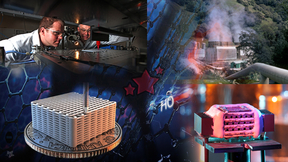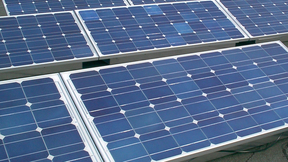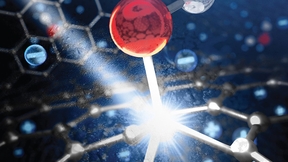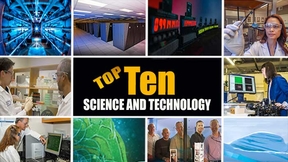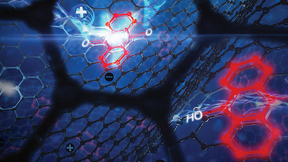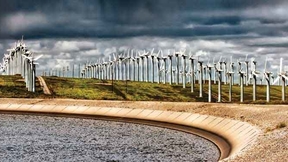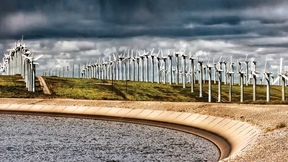Back
LIVERMORE— Lawrence Livermore National Laboratory (LLNL), in partnership with Lawrence Berkeley National Laboratory (LBNL) and Sandia National Laboratories/California (SNL/CA), have been awarded $4.15 million by the Department of Energy (DOE) to jointly launch a new small business voucher pilot.The three-way national lab partnership, known as LabSTAR, will be funded under…
SAN FRANCISCO – Through the public-private consortium CalCharge, energy storage companies will soon have unprecedented and streamlined access to three U.S. Department of Energy national labs in the Bay Area — giving them a major competitive advantage in the fast-growing battery industry.CalCharge, which is designed to accelerate the development and deployment of energy…
Americans' energy use continued to grow slowly in 2014, fueled by increases in the use of natural gas, wind and solar, according to the most recent energy flow charts released by Lawrence Livermore National Laboratory.Each year, the Laboratory releases charts that illustrate the nation's consumption and use of energy. Overall, Americans used 0.9 quadrillion (quads) British…
Lawrence Livermore researchers have identified electrical charge-induced changes in the structure and bonding of graphitic carbon electrodes that may one day affect the way energy is stored.The research could lead to an improvement in the capacity and efficiency of electrical energy storage systems, such as batteries and supercapacitors, needed to meet the burgeoning…
Using the same baking soda found in most grocery stores, Lawrence Livermore scientists, along with colleagues from Harvard University and the University of Illinois at Urbana-Champaign, have created a significant advance in carbon dioxide capture.The team developed a new type of carbon capture media composed of core-shell microcapsules, which consist of a highly permeable…
In 2014, Lawrence Livermore National Laboratory (LLNL) built on a 62-year tradition of translating basic science into technologies that ensure national security, address pressing real world problems and expand the boundaries of fundamental science.The top stories of the year are a reflection of the Laboratory’s ability to apply its core national security competencies to a…
Physics World, an international monthly magazine published by the Institute of Physics, has named the National Ignition Facility’s (NIF) achievement of fuel gain one of its top 10 breakthroughs of the year. Ignition — the process of releasing fusion energy equal to or greater than the amount of energy used to confine the fuel — has long been considered the "holy grail" of…
LIVERMORE, Calif. – General Atomics’ DIII-D Tokamak has been a critical part of the nation’s magnetic fusion energy research since it was built in the 1980s.Over the years, wear and tear has taken its toll. However, it was impossible for researchers to see inside the San Diego company’s highly complicated machine to assess damage -- until now.Lawrence Livermore National…
Personal electronics such as cell phones and laptops could get a boost from some of the lightest materials in the world.Lawrence Livermore researchers have turned to graphene aerogel for enhanced electrical energy storage that eventually could be used to smooth out power fluctuations in the energy grid.The team found that graphene aerogel-based supercapacitor electrodes…
High performance computing (HPC) will be used to develop and apply the most complete climate and Earth system model to address the most challenging and demanding climate change issues. Eight national laboratories, including Lawrence Livermore, are combining forces with the National Center for Atmospheric Research, four academic institutions and one private-sector company…
Lawrence Livermore scientists are working on a project that will use particles considerably smaller than the size of a human hair to improve the storage capacity of hydrogen-powered vehicles.Using $1.2 million from the Department of Energy's Office of Energy Efficiency and Renewable Energy (EERE) over three years, LLNL scientist Brandon Wood said that through theory and…
Americans used more renewable, fossil and even nuclear energy in 2013, according to the most recent energy flow charts released by Lawrence Livermore National Laboratory.Each year, the Laboratory releases energy flow charts that illustrate the nation's consumption and use of energy. Overall, Americans used 2.3 quadrillion thermal units more in 2013 than the previous year…
The rain in Spain may lie mainly on the plain, but the location and intensity of that rain is changing not only in Spain but around the globe.A new study by Lawrence Livermore National Laboratory scientists shows that observed changes in global (ocean and land) precipitation are directly affected by human activities and cannot be explained by natural variability alone. The…
Human influences have directly impacted the latitude/altitude pattern of atmospheric temperature. That is the conclusion of a new report by scientists from Lawrence Livermore National Laboratory and six other scientific institutions. The research compares multiple satellite records of atmospheric temperature change with results from a large, multi-model archive of…
LIVERMORE, Calif. - The use of plasmonic black metals could someday provide a pathway to more efficient photovoltaics (PV) -- the use of solar panels containing photovoltaic solar cells -- to improve solar energy harvesting, according to researchers at Lawrence Livermore National Laboratory (LLNL).The LLNL Materials Engineering Division (MED) research team has made…
From developing the first accelerator mass spectrometer for use in the biology field to tracking radionuclides from the Dai-ichi Nuclear Power Plant disaster, the Laboratory's Center for Accelerator Mass Spectrometry (CAMS) has spent 25 years in the spotlight of not only dating ancient artifacts but solving global challenges.CAMS is celebrating its 25th anniversary this…
Research conducted at the Center for Accelerator Mass Spectrometry (CAMS) spans the universe, the depths of time and everything in between. Although not all elements and isotopes are able to be utilized by AMS, CAMS' researchers make the most of what nuclear physics has given them.Here is a sampling of some of the many ways CAMS is utilized, along with the important…
Americans used more natural gas, solar panels and wind turbines and less coal to generate electricity in 2012, according to the most recent U.S. energy charts released by Lawrence Livermore National Laboratory . Each year, the Laboratory releases energy flow charts that track the nation's consumption of energy resources. Natural gas use is up particularly in the…
LIVERMORE, Calif.-- Lawrence Livermore National Laboratory researchers have broken the record for tracking the movement and concentration of carbon dioxide in a geologic formation using the world's deepest Electrical Resistance Tomography (ERT) system.The research provides insight into the effects of geological sequestration to mitigate the impact of greenhouse gases.The…
LIVERMORE, Calif. -- Lawrence Livermore scientists have discovered and demonstrated a new technique to remove and store atmospheric carbon dioxide while generating carbon-negative hydrogen and producing alkalinity, which can be used to offset ocean acidification.The team demonstrated, at a laboratory scale, a system that uses the acidity normally produced in saline water…

